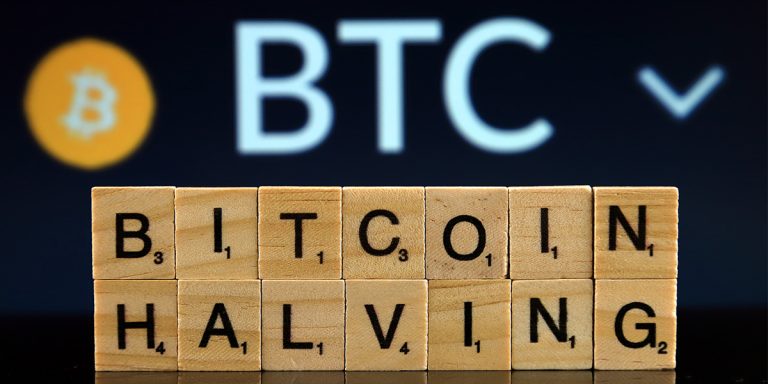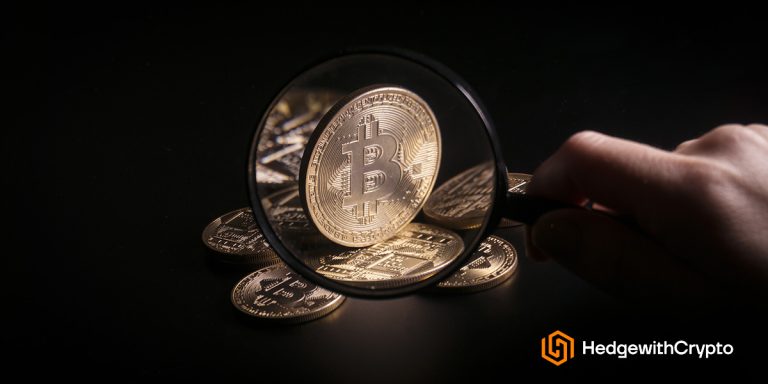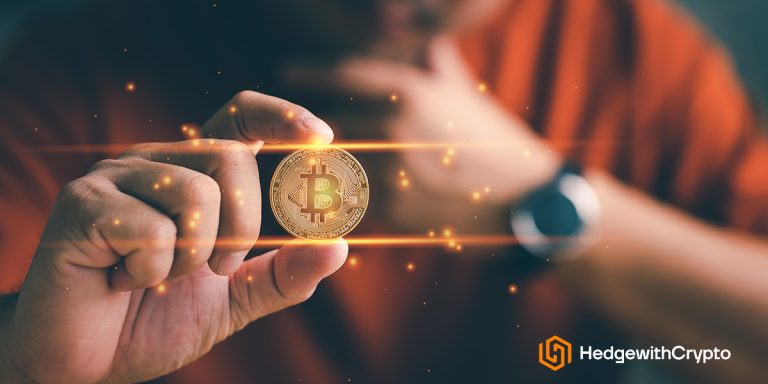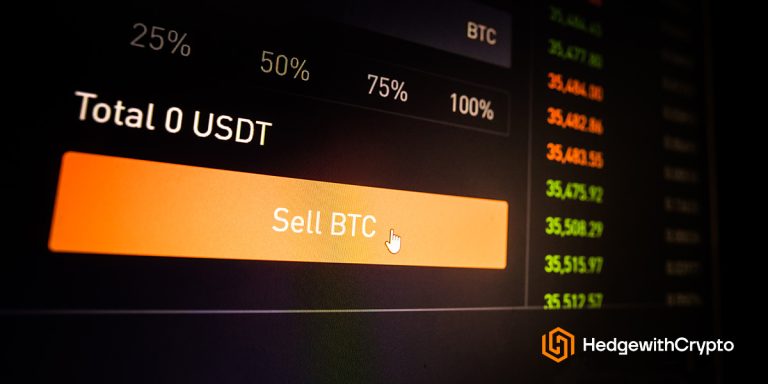Bitcoin Transaction Fees: This Is How Much You Need To Pay
Key Takeaways:
- The average fee for transacting Bitcoin is USD 3.76.
- Bitcoin transaction fees were at their highest in April 2021 when they cost approximately $60 per BTC.
- In comparison to traditional payment processors such as PayPal where transaction fees are higher, it is generally cheaper to transact Bitcoin.
TABLE OF CONTENTS
Bitcoin Transaction Fees Explained
The average Bitcoin transaction fee is USD 3.76 at the time of writing, which is the lowest it has been in the last 5 years. The USD TX fee for Bitcoin is not constant and fluctuates over time depending on the network congestion. The fee is only incurred when a transfer on the BTC blockchain is processed and validated by a miner or mining pool.
How High Do Bitcoin Transaction Fees Go?
Whether it is proof-of-stake, proof-of-work, or non-blockchain, all computer networks are limited by data throughput. This limitation is greatly exacerbated with blockchain networks because all network participants take part in confirming transactions as valid, which takes time and resources. Based on these two factors — limitation and decentralization — Bitcoin’s transaction fees are highly dependent on the daily network volume.
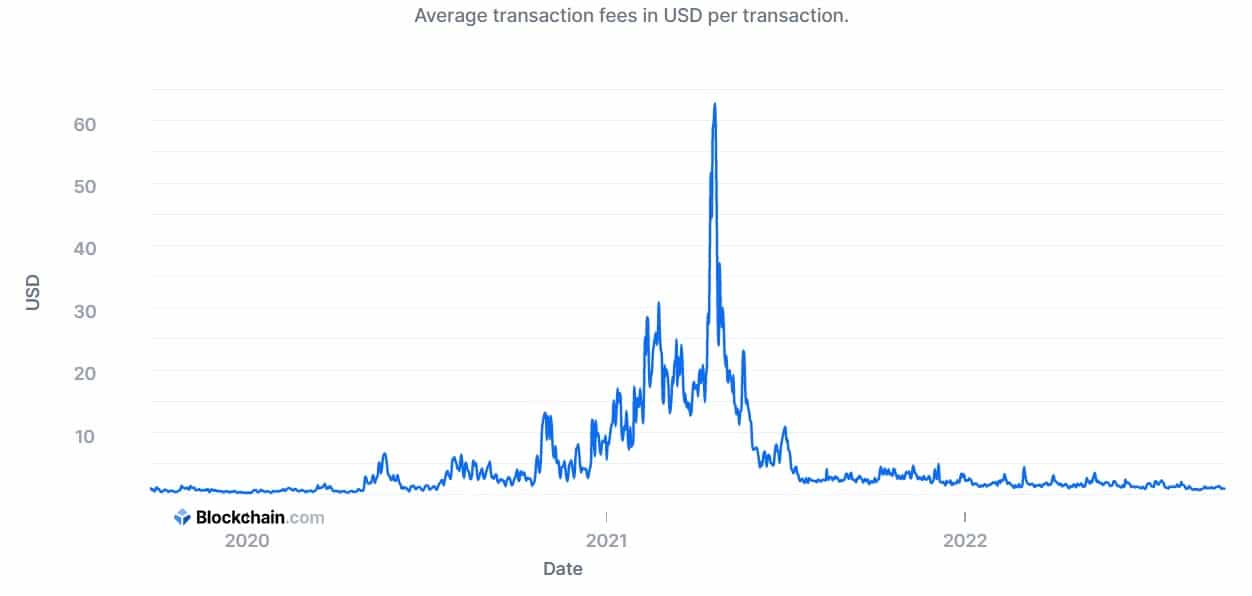
At the height of the bull market in April 2021, the Bitcoin transfer fee reached its highest point at ~$60 per BTC transaction. Since then, the Bitcoin transaction fees have plummeted and remained at record lows, at ~$1 per transaction. There are multiple reasons why this happened. But first, let’s dive into Bitcoin’s monetization mechanism.
The Reasons Bitcoin Has a Transaction Fee
Without robust and fair monetization, the Bitcoin network would have remained on the fringes of voluntarism. Instead, in its 13 years of working without shutting down, the network has grown to over 11,000 nodes, creating a digital asset that reached a $1.26T market capitalization in November 2021.
Bitcoin nodes are computers interlinking with others, running software that validates each transaction before adding it as a new data block. For their transfer validation service, node operators — dubbed miners — receive a cut of the new data block, which is BTC. This is miner revenue, depending on market bull runs that elevate BTC price. May 2021 was the most profitable year for Bitcoin miners, having reached $300 in revenue per transaction. This should not be confused with the Bitcoin transaction fee.
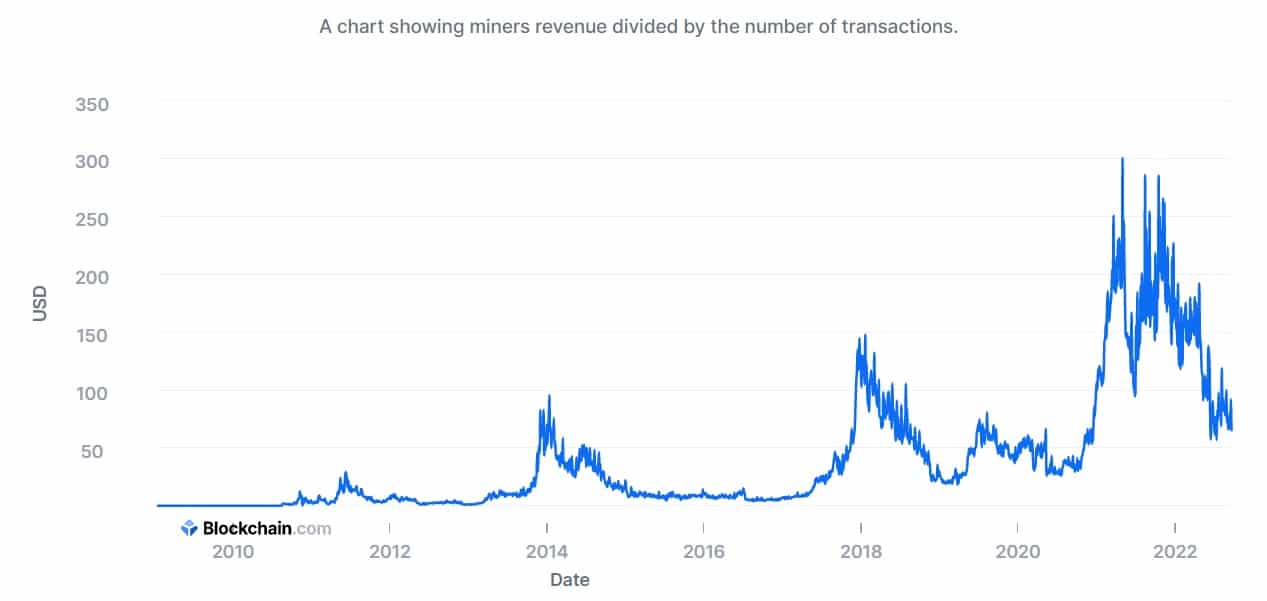
The pseudonymous Satoshi Nakamoto created such a system to eliminate spam. In fact, the email service itself would've employed such a disincentive mechanism in an alternative timeline. Instead, we are left with zero-cost email, which leads to never-ending spam. Outside of preventing transaction spam, miner BTC rewards facilitate the network's undirected self-growth, as miners profit from maintaining the network.
Related: How to mine Bitcoin and earn rewards.
Who Pays the Bitcoin Transaction Fee?
Bitcoin transactions are encoded in Blockchain’s network as a percentage of each transaction. In July 2010, a year after the cryptocurrency was launched, contributor Gavin Andresen tweaked the Bitcoin code to have a $187.74 minimum transfer fee. Later, this threshold was removed as Bitcoin began to grow in popularity. For the majority of the network’s operation, the percentage of the cut from transaction volume has held under 2%.
Any time a sender transfers Bitcoin from one address to another, they pay a fee in a percentage range. As such, these transactions integrate the BTC fee cut when a transfer from address A to address B happens. In turn, the cut serves as Bitcoin miners’ revenue. Their most profitable month occurred in October 2021, when they collectively earned $74.4M worth of bitcoins.
Of course, miners can choose whether to hold that BTC or sell it on an established cryptocurrency exchange to receive fiat money to cover their expenses. If they wait and the BTC price drops significantly, they risk not having enough money to cover expenses or expand mining operations.
This Is How Bitcoin Transaction Fees Are Calculated
As with any transaction fee, the Bitcoin transfer fee is a difference between the starting price of the Bitcoin that is sent and the one that is received. For example, if Person A were to send 10 BTC to Person B, they would likely receive 9.999995 BTC. In other words, Bitcoin senders always pay the transaction fees while receivers get the cryptocurrency for free. In this case, Person A would have to pay roughly 500 satoshi, or 0.00000500 BTC, given that 1 satoshi is 100 millionth (1e8) of one BTC.
From this example, we can see the implication. One can only estimate the BTC transfer fee because it depends on the size of the transaction in Bytes, the current network load, and the price of Bitcoin. Here is how that works in greater detail:
- As the name suggests, a blockchain is made of data blocks, representing transactions. Each one can hold up to 4,000 transactions.
- In the Bitcoin network’s current configuration, blocks are limited in size to less or equal to 1 million Bytes (more after the SegWit upgrade).
- On average, miners generate one block per roughly ten minutes.
- Miners bid for which transactions to include in the new block, from which they receive BTC revenue.
Therefore, miners are incentivized to maximize their profits when generating new blocks. This leads them to pick 1 million Byte transactions, as the upper limit. You might have guessed at this point that the transfer value for miners is completely irrelevant. Instead, it’s all about squeezing the Bytes, as bundled transactions’ size.
In other words, because miners are limited to 1M Bytes, they only care about the fee per Byte. In turn, miners can also set a minimum fee per block. Depending on the traffic load, the minimum fee makes the transaction speed the longest, about one hour to be confirmed. Typically, large Bitcoin mining pools prioritize only high-fee transactions.
All of this is visible in Bitcoin’s MemPool tracker, telling you what the average Bitcoin transaction fees you can expect at any given time period, depending on the speed of transactions. To learn how fast it takes to send Bitcoin, read this article next.
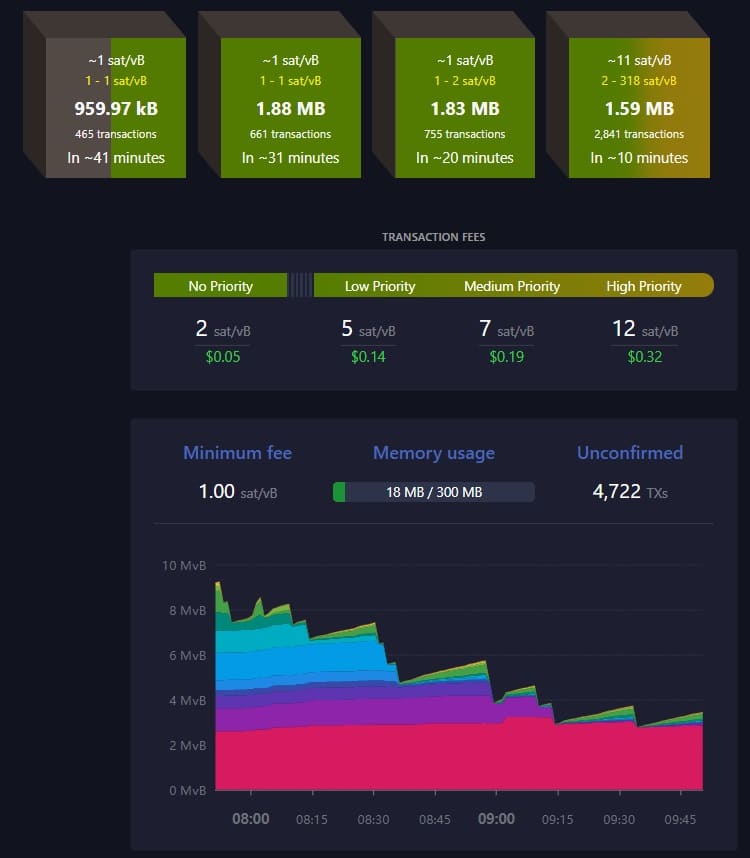
As you can see, Bitcoin fees have drastically come down since 2021, to less than a dollar, or up to 1,504 sat (satoshi) per vB. Additionally, one should notice the difference between B (for Byte) and vB (for virtual Byte). The latter is a consequence of the SegWit (Segregated Witness) upgrade, implemented in August 2017.
Bitcoin SegWit Has Affected The Transaction Fees
Because SegWit separates transaction data from its signature, Bitcoin network users pay lower fees than before the upgrade. The upgraded protocol is superior to Bitcoin’s original network as it moves all transaction signature data to the end of the Bitcoin block. This allows for all transactions’ signatures to be piled up together and processed as such. Putting it differently, a Byte in Bitcoin’s legacy network (non-witness) is equal to 1 virtual Byte. With SegWit enabled, a Byte in the witness transaction accounts for ¼ of a virtual Byte.
That figure is a result of SegWit expanding the block limit size from 1MB to 4MB. Therefore, virtual Bytes are simply converted block measurements, as the size is divided by 4. For the end user, sats/vB simply represents a SegWit discount. Cryptocurrency exchanges had to upgrade their systems to allow for this upgrade, which took years to accomplish after SegWit was implemented on Bitcoin’s main net.
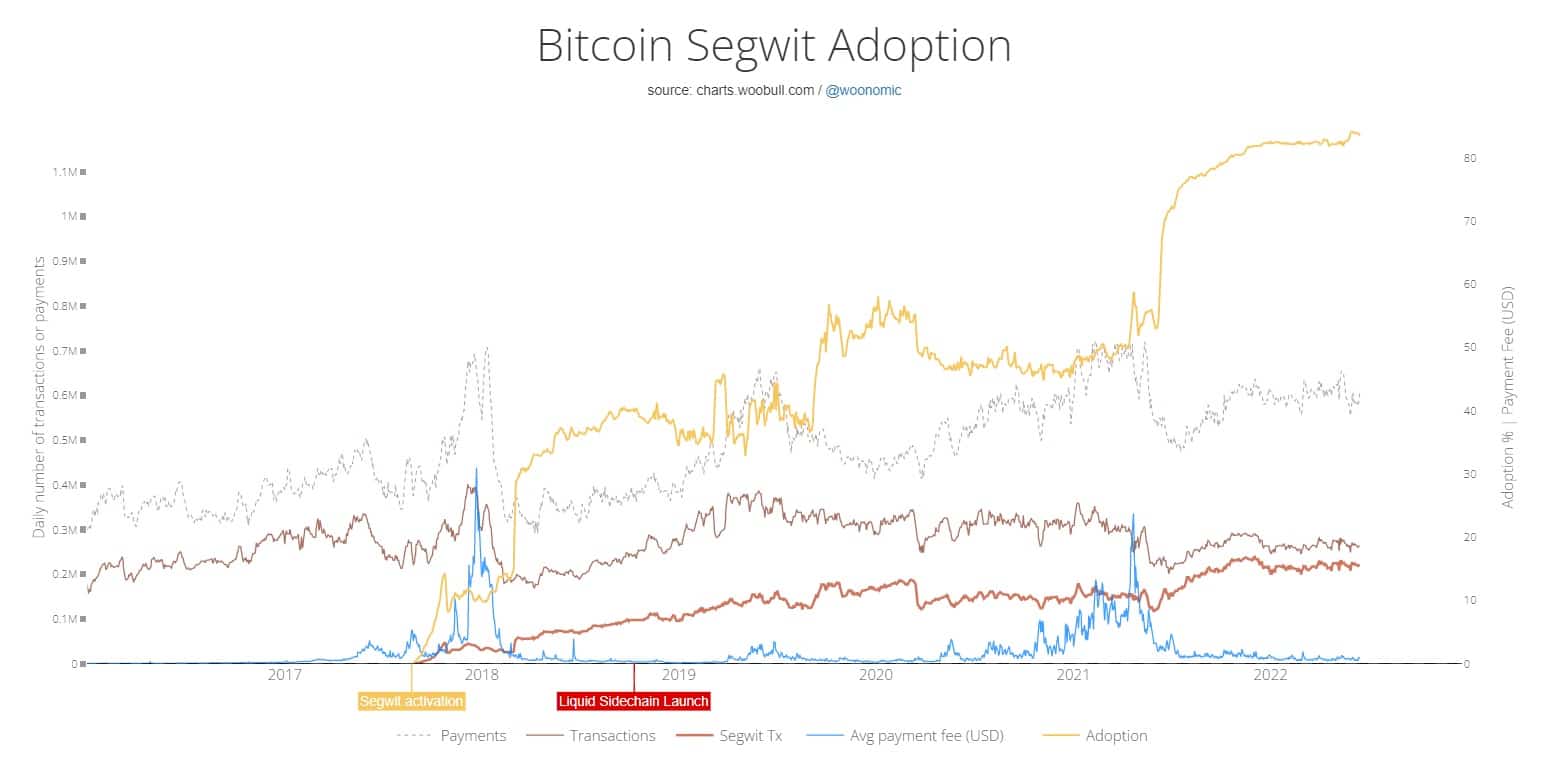
As you can see from this chart, exchanges implementing SegWit were responsible for that, as the upgrade facilitated batched transactions. Moreover, the Lightning Network joined SegWit forces to further lower Bitcoin transfer fees and keep them down.
Expect to Pay Less Fees With The Lightning Network
In addition to the SegWit upgrade, Bitcoin takes advantage of another scalability solution to make transfer fees cheaper and faster. This is the Lightning Network (LN), a Layer 2 network for Bitcoin, just like Arbitrum or Optimism are for Ethereum. Instead of dealing with Bitcoin’s mainnet (Layer 1), LN works on top of it so that Bitcoin’s security is not compromised. LN creates payment channels between senders and receivers, in which only the last and first are processed on Layer 1.

Because the middle transactions aren’t executed on Layer 1, Bitcoin’s network limitations are removed. Theoretically, this makes LN infinitely scalable, which has already been demonstrated. For example, LN can process transactions as fast as a Visa payment network.
This makes LN critical for wide-scale global adoption, transforming Bitcoin from a store of value to a daily cryptocurrency with minimal transaction fees. Speaking of which, the base fee per BTC transaction is just 1 satoshi (0.00000001 BTC), equivalent to $0.0002 USD. From 2019 to 2022, LN increased its channel count by 377%. As of September 2022, LN increased its cumulative BTC capacity to 4.7k BTC across all payment channels (blue is USD value while orange is BTC).
Cheaper Bitcoin Transaction Fees Will Increase Global Adoption
Bitcoin has undergone massive changes in the last two years. For the first time in its history, a bull run in November 2021, when BTC reached its ATH of $69k, did not cause enormous fees. Thanks to the SegWit upgrade and Lightning Network, Bitcoin’s poor TPS limit of only 7 became much less of an obstacle than ever before.
Moreover, much depends on how Bitcoin is used. The majority of investors still see it as a long-term investment, as shown in the latest Gemini global state of crypto report. If this trend continues and is combined with the LN, Bitcoin’s network pressure will ease from multiple directions. In the end, users can pay the negligible 2 sats/vB if they can settle waiting for a day or two.
Frequently Asked Questions
Can You Choose The Bitcoin Transaction Fee?
Yes, most crypto exchanges and wallets allow the sender to select the priority of the transaction and the associated fee rate. The options include paying higher transaction fees to get a priority confirmation in the next block or paying a reduced amount with a slower transaction processing time. The fee options to select will be shown in satoshis per unit of data and abbreviated as sats/vByte.
Can You Avoid The Bitcoin Transaction Fee?
No, transactions that are confirmed and validated on the Bitcoin network will always incur a transaction fee that is settled and paid to the miners. Due to the decentralized network of the Bitcoin blockchain, paying transaction fees are unavoidable, although, there are ways the fee can be reduced such as opting for a slower transaction time.
Are BTC Transfer Fees Taxable Events?
In the United States, Bitcoin is treated as a commodity, subject to capital gains taxation. Meaning, if one trades or sells BTC and gains a profit, it has to be reported to the IRS. However, Bitcoin transaction fees are tax deductible events. Therefore, when Bitcoin holders trade their bitcoins and receive a gain, associated fees for those gains are deducted from the reportable tax event.

